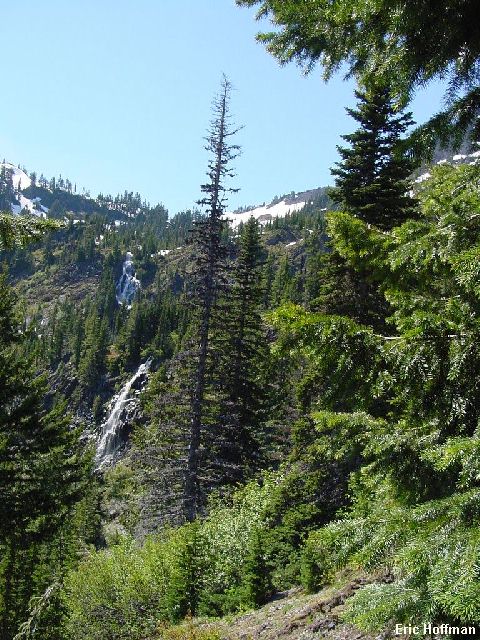A view from The Lake of the Angels way trail

I haven't done a lot of climbing in the Olympics and all of the climbs have been on the east side, but I have just come to expect that most of the rock will be in one of three forms: pillow lava, scree, and some sort of "rock" that will become scree if you touch it. The pillow lava is fun, the scree is not always pleasant and the other, well its just scary. Since I don't consider the rock to be ideal, there must be some other attraction.
Mount Stone is located just inside the Olympic Park Boundary, but the route begins in unprotected National Forest land then crosses the narrow NE panhandle of the Skokomish Wilderness, before finally entering the park. Access is via Hamma Hamma Recreation Road (FSR 25), which is currently washed out at c.10.5 miles, about 1.2 miles short of the Putvin Trail Trailhead. Carl Putvin (1892-1913) was an early explorer of the Olympics whose grave is just off the trail a short distance from the trailhead. The Putvin Trail (FST 813) follows the west side of Boulder Creek for a few hundred feet before it embarks on a long traverse to the west. Near the end of the traverse, at 1.3 miles, the trail crosses an old road (go downhill to pick up the trail again) then enters the Skokomish Wilderness. The maintained trail ends in a basin at 3.9 miles but a way trail continues on to The Lake of the Angels, making its way up some steep, rocky terrain by way of an interesting route with nice views.
|
A view from The Lake of the Angels way trail |
|
|
Once above the steep section, the trail works its way to another basin with a pond at c.4,500'. This is where Route 1 in the Climber's Guide to the Olympic Mountains leaves the trail and ascends NNE to a notch in the west ridge of Mount Stone. Route 1 is the most direct but I also wanted to check out The Lake of the Angels and get a look at Mount Skokomish so I continued on the trail but soon lost it in the snow on the west side of the basin where there was easy snow to the lake. The standard route on Mount Stone looks a bit rocky and brushy for a couple of hundred feet but then becomes easier as it traverses under St Peters Gate, a pass SE of the summit.
|
Lake of the Angels with Mount Skokomish in the background |
|
|
After checking out the small Lake of the Angels, I began toward Mount Stone. From the lake I ascended about 800 feet then crossed to the North side of a rock rib. I climbed the north side of the rib which merges with what becomes the West Ridge. I ascended the ridge until it became obvious that I wasn't going to be able to stay on it all the way to the notch where the standard route gains the ridge. I was nearly at the notch but I was forced to descend about 200 feet then climb to it. Once at the notch, the route scrambles (class 3) up a couple hundred feet to a shallow hanging basin. From here a traverse around the basin leads to the blob that is the main summit of Mount Stone.
|
The South and Middle Peaks of Mount Stone from the West Ridge |
|
|
More scrambling (class 3) quickly leads to the top where views await. To the north is the middle summit which has a huge block that seems to be held on a steep slab by nothing more than friction. Farther west is the crown jewel of the Olympics. To the south is the massif created by Pershing, Washington and Ellinor. The east holds Hood Canal, Puget Sound and the Cascades.
|
The Middle Peak of Mount Stone |
|
|
|
Mount Olympus from the summit of Mount Stone |
|
|
|
The Pershing-Washington-Ellinor Trio from the East Ridge of Mount Skokomish |
|
|
I descended back toward the lake and started my way towards 6,434 foot high Mount Skokomish. A class 2 route on the south side leads to its summit, but I had been checking out the East Ridge which looked like it would be easy until near the summit and is not documented as a route. Lots of class 2 and some 3 on less than great rock turned to knife edged and serated. I wasn't going to the summit on this ridge but the views were nice.
|
Mount Stone from the East Ridge of Mount Skokomish |
|
|
On the way down I ran into a bear just before reaching the maintained trail. It reacted in National Park fashion as I yelled at it. A few grunts, nose to the ground, wandering almost aimlessly. Back to the question of why do go to the Olympics. Maybe it is just the change of scenery?
|
One other reason to climb in the Olympics |
|
|
References:
Climbers Guide to the Olymic Mountains; Olympic Mountain Rescue; Pages 49-54
Olympic Mountains Trail Guide, Second Edition; Robert L. Wood; Pages 166-168